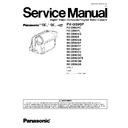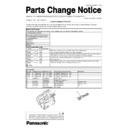Read Panasonic PV-GS90P / PV-GS90PC / PV-GS90PL / NV-GS90EG / NV-GS90E / NV-GS90EB / NV-GS90EP / NV-GS90EE / NV-GS90EF / NV-GS90EK / NV-GS90GC / NV-GS90GCS / NV-GS90GN / NV-GS98GK Service Manual online
PV-GS90PL
NV-GS90EG
NV-GS90E
NV-GS90EB
NV-GS90EP
NV-GS90EE
NV-GS90EF
NV-GS90EK
NV-GS90GC
NV-GS90GCS
NV-GS90GN
NV-GS98GK
(S)....................Silver Type
part on the equipment such as screwheads, connectors,
control shafts, etc. When the exposed metallic part has a
return path to the chassis, the reading should be between
1M
may be used to make the hot checks, leakage current must
not exceed 1/2 mA. In case a measurement is outside of
the limits specified, there is a possibility of a shock hazard,
and the equipment should be repaired and rechecked
before it is returned to the customer.
Schematic Diagrams, Circuit Board Layout, Exploded Views and Replacement Parts List. It is essential that these critical parts
should be replaced with manufacturer’s specified parts to prevent X-RADIATION, shock fire, or other hazards. Do not modify
the original design without permission of manufacturer.
from electrical shocks. It will also protect AC Adaptor from being damaged by accidental shorting that may occur during
servicing.
Electrostatic Sensitive (ES) Devices. Examples of typical ES devices are integrated circuits and some field-effect transistors and
semiconductor “chip” components. The following techniques should be used to help reduce the incidence of component damage
caused by electrostatic discharge (ESD).
which should be removed for potential shock reasons prior to applying power to the unit under test.
4. Use only an antistatic solder removal device. Some solder removal devices not classified as “antistatic (ESD protected)” can
6. Do not remove a replacement ES device from its protective package until immediately before you are ready to install it. (Most
conductive material).
CAUTION:
sufficient to damage an ES device).


